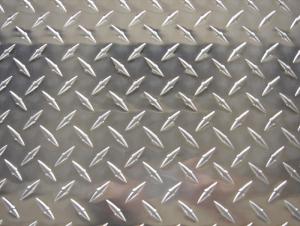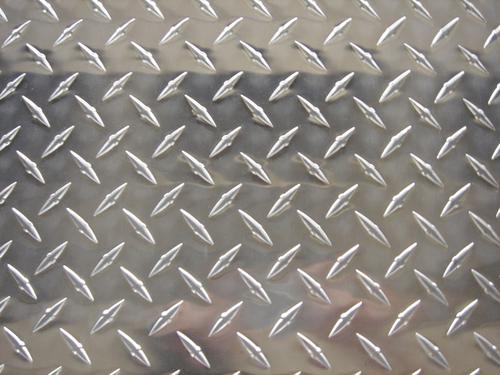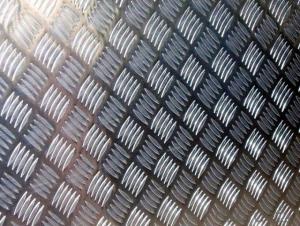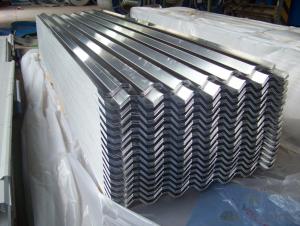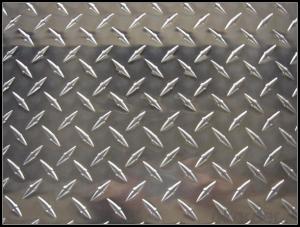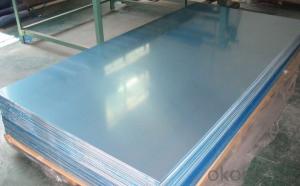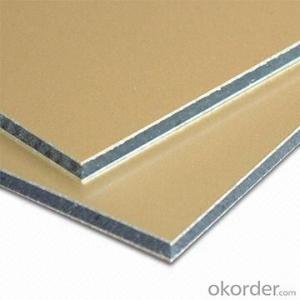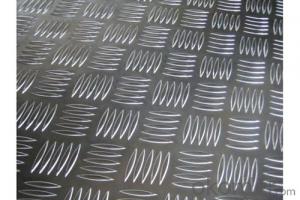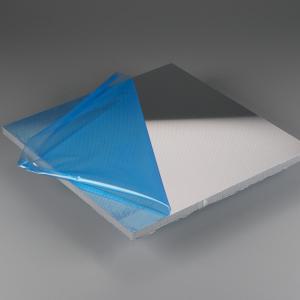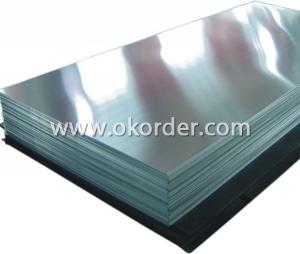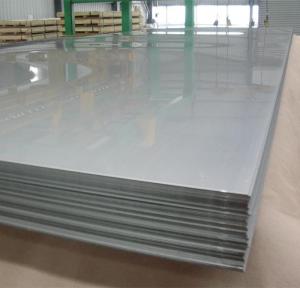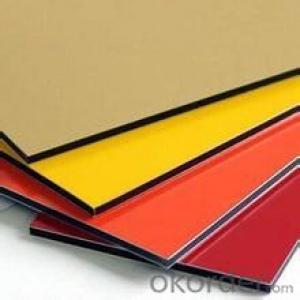0.040 Aluminum Sheets 4x8 - Aluminium Diamond Treadplate
OKorder Service Pledge
OKorder Financial Service
You Might Also Like
Aluminum treadplate
Specifications
Alloy: A1100 and A3003
Temper: H14 or H24
Pattern: Diamond
Thickness:1.0-8.0mm
Width:750--1500mm
Lenght:800-8000mm or by customer requirement.
Product | Alloy | Temper | Thickness(mm) | Width (mm) | Length (mm) |
Aluminum tread plate | 3003 |
H14,H22,H24 T6 | 1.0-8.0 | 900-1500 | 800-8000 |
5754 | |||||
5052 | |||||
5086 | |||||
6061 |
Advantage:surface very bright.
We can produce according to ASTM,JIS,EN standard.
Place of Origin: China
Minimum Order Quantity: 5 Tons
Packaging Details: In standards seaworthy wooden cases
Payment Terms: LC or T/T
Packaging & Delivery
Packaging Detail: | Standards seaworthy packing by wooden pallets |
.Delivery Detail: | within 30 days after receive LC or deposit. |
- Q: why could aluminum pot be repaired by knocking the aluminum sheet into the pot but not being bonded by glue?
- the oxidation rate of aluminum's surface is very quick, so we cann't use the method of tin welding, and the cost of argon arc welding is very high,so aluminum pot's repair usually uses riveting. aluminum has low hardness and good ductility, so it can be repaired by tightly knocking, without the bonding of glue. general glue will decomposed in open fire, if we bond pot by glue, the pot after repair won't be able to endure high temperature.
- Q: Can 101 aluminum sheets be used in the production of consumer electronics?
- Yes, 101 aluminum sheets can be used in the production of consumer electronics. Aluminum is a lightweight and durable material that is commonly used in various electronic devices, including smartphones, laptops, and tablets. The specific grade of aluminum, such as 101, determines its properties and suitability for different applications.
- Q: Are aluminum sheets suitable for roofing?
- Indeed, aluminum sheets prove to be a fitting choice for roofing purposes. Renowned for its lightweight nature, durability, and corrosion resistance, aluminum stands out as a favored material in the roofing industry. Moreover, its non-combustible properties render it a safer alternative. The ease of installation and maintenance further add to its appeal, as do its ability to withstand adverse weather conditions like heavy rain, snow, and wind. Notably, aluminum also earns accolades as an environmentally conscious option, boasting 100% recyclability. In summary, aluminum sheets offer a trustworthy and enduring roofing solution for both residential and commercial edifices.
- Q: What are the different grades of aluminum sheets available?
- There are several different grades of aluminum sheets available, including 1100, 3003, 5052, and 6061. These grades vary in terms of their composition, strength, and intended use. 1100 aluminum is the most commercially pure grade and is often used for general purpose applications. 3003 aluminum is alloyed with manganese and has improved strength and corrosion resistance. 5052 aluminum is alloyed with magnesium and has excellent weldability and formability. 6061 aluminum is alloyed with magnesium and silicon and is known for its high strength and versatility.
- Q: Do aluminum cans melt in typical campfires? I know the melting point is about 660 Celsius but do campfires get that high? I thought it would just be that the can becomes disfigured and collapses due to the heat, not due to it melting. Even if it did melt in the fire how would you find the remains? The can in a liquid form would certainly not be confined to one part of the fire and therefore wouldn't solidify in a small pool to see if it had melted or not. Any ideas?
- A campfire does not get hot enough to melt Aluminum.
- Q: Are the aluminum sheets suitable for manufacturing automotive body panels?
- Indeed, automotive body panels can be manufactured using aluminum sheets. Aluminum, being a material that is both lightweight and robust, presents numerous advantages in the realm of automotive applications. Its high ratio of strength to weight enables enhanced fuel efficiency and superior overall vehicle performance. Furthermore, aluminum boasts exceptional corrosion resistance, rendering it suitable for enduring adverse environmental conditions. Moreover, its malleability and ease of manipulation facilitate the creation of intricate designs and shapes essential for automotive body panels. These attributes have established aluminum sheets as a highly favored option within the automotive industry for the production of body panels.
- Q: hi my house is wired with aluminum wire and we have this light that has been changed 6 times because originally there was a cheap builders light up there that got replaced with a ceiling fan but the ceiling fan was replaced a couple of times since the remote never worked properly on any of the cieling fans so finally we replaced the cieling fan with just a normal light but now the socket got cracked on the new light by accident. The problem is im wondering if it is safe to put another light up because i have heard aluminum wire breaks easy and the wires have been moved around alot. But if i dont replace the light i wont have a light. We also use the correct wire nuts and anti oxidant on the connections. Also when the 4 cieling fans that had been put up were wired correctly since i have put up many cieling fans up without remotes before. Also Is there a certain number of times aluminum or copper wire can be bent with out having to worry about a fire happening or the wire breaking.
- You can never ever connect an Aluminum wire to a Copper wire. Never, copper in contact with aluminum and a bit of moisture acts like a Battery. Remember the old Grade School experiment where students made a battery using copper pennies and aluminum foil by simply contacting the foil to several pennies, then lighting a neon bulb! So copper in contact with aluminum creates a galvanic action due to potential difference and thus can cause a hot spot and a fire can literally break out in the junction box where you made the connection. Keep this always in mind since you have a whole house of that aluminum wire. To connect aluminum wire to a fixture you need a fixture that will accept an aluminum wire. Check that with the hardware or where or Lowes or wherever you buy the fixture from. There are fixtues with contacts points for wire in them that accept both copper and aluminum wire. So you do not need to replace the wire just to install the fixture. Or you can go to Lowes and get a special connector that safely connects the aluminum wire to a short piece of copper wire and then connect that copper pigtail piece to any fixture you buy. The danger of aluminum wire has never been that becomes brittle, but that corrosion forms at screw joints in the switches, outlet boxes and the like, that causing a resistance and that resistance acting literally like a heater and becoming red hot and starting a fire.
- Q: on the metal activity series, aluminum sits between magnesium and zinc, and all three sit above hydrogen. Explain why aluminum typically reacts only slowly with dilute acids even though both magnesium and zinc react rapidly
- Aluminum metal reacts with oxygen in the air to form a very tightly bonded aluminum oxide on its surface which slows the attack of acids trying to make contact with the aluminum atoms below the surface.
- Q: What is the typical thickness tolerance for aluminum sheets?
- The typical thickness tolerance for aluminum sheets can vary depending on the specific application and industry standards. However, in general, the accepted thickness tolerance range for aluminum sheets is typically within ± 0.005 to ± 0.015 inches. This means that the actual thickness of the sheet may vary within this tolerance range from the specified thickness. It is important to note that different industries may have different tolerance requirements based on the intended use of the aluminum sheet, so it is always advisable to consult the relevant industry standards or specifications for specific tolerance requirements.
- Q: Hello,Does it matter what kind of wheel I use as a cut off wheel on an angle grinder when cutting aluminum?Thanks!
- Yes but its for general purpose straight cuts. I've been using a Metabo cutting wheel in lieu of a torch for cutting,including stainless that's 3/16 or less. They work great, are inexpensive, and fit angle grinders.
Send your message to us
0.040 Aluminum Sheets 4x8 - Aluminium Diamond Treadplate
OKorder Service Pledge
OKorder Financial Service
Similar products
Hot products
Hot Searches
Related keywords
